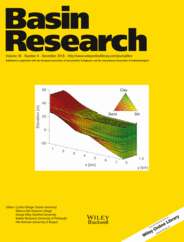
Full text loading...
Previous studies on the Lower‐Middle Jurassic Cuyo Group in the southern Neuquén Basin, Argentina, have discussed evidence for pre‐ and syn‐depositional structural inversion during pre‐Andean shortening. While the Cuyo Group sequence stratigraphic and facies framework are well understood, the effects of structural inversion and progressive postrift thermal subsidence on sediment provenance and dispersal, as well as the timing and magnitude of deformation during and after Cuyo Group deposition, remain poorly constrained. The Cuyo Group comprises both reservoir‐quality fluvial to deep‐marine siliciclastic deposits and a petroleum source‐rock. Thus, the temporal relationship between the onset of deformation and sediment dispersal are crucial aspects for an improved understanding of both the basin evolution and petroleum system. This study presents new detrital zircon (U‐Th)/(He‐Pb) double dating from the Los Molles and Lajas Formations of the Cuyo Group in the southern area of SW Zapala to evaluate the influence of early rift inversion on sediment routing, provenance, and palaeogeography, and to provide crucial chronostratigraphic constraints. The youngest concordant Jurassic detrital zircon (DZ) U‐Pb and He ages from the Lajas and Los Molles Formations in Lohan Mahuida and La Jardinera areas suggest a late Middle Jurassic depositional age. The DZ U‐Pb provenance analysis confirms that both formations are part of the same Middle Jurassic shelf margin and were both sourced from the Choiyoi basement, Late Triassic to Middle Jurassic Andean magmatic arc and pre‐Cuyo Group strata. The detrital He (DZHe) ages provide additional provenance constraints by recording three discrete cooling events, (1) early‐Late Triassic, (2) early‐Early Jurassic, and (3) Middle‐Late Jurassic, documenting tectonically driven exhumation during rifting and contractional stages prior to and during early Neuquén basin evolution. Triassic‐Jurassic He cooling ages of zircons derived from the Choiyoi Group document the existence of pre‐Cuyo Pangean extensional structures and basins in the source area. Furthermore, the abundance of rapidly cool DZHe ages requires rapid exhumation of both Choiyoi and Carboniferous basement. All of this evidence suggests that structural inversion in the Huincul ridge region started in the Middle Jurassic, earlier than previously proposed. Hence, this challenges conventional Cuyo Group tectono‐depositional models that advocated postrift thermal sagging as the primary control on subsidence and deposition. The occurrence of first‐cycle volcanic (U‐Th)/(He‐Pb) ages implies that the Cuyo Group burial never reached depths >4–5 kilometres. Exhumation to shallower crustal depths was spatially partitioned and driven by Cenozoic Andean shortening as constrained by AHe ages.

Article metrics loading...

Full text loading...
References


Data & Media loading...
Supplements

